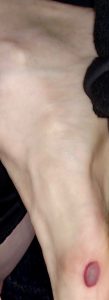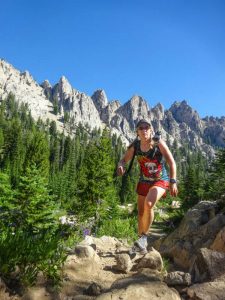Fix Your Running Blisters with Hip Alignment Exercises: Gadrie's Story
Sep 19, 2018

Guest Blog: Gadrie Edmunds
I started running regularly when I was 19 or 20 to try and lose weight and get in shape. Not knowing any better, I started off running in aerobics shoes. I don’t know if the shoes contributed to it, or if I just took a bad step one day, but somewhere in that first year or so I ended up with a partial tear of my right Achilles tendon. So that I could allow the swelling to resolve, I took some time off running. Then, I went through PT / rehab and hit the road again.
On the advice of the PT who helped me with the injury, I went into a running shoe store to get fitted for better shoes. During that first evaluation, I was told I overpronate, particularly on the right side. Even while standing, the salesman said my arch was collapsing. The odd thing was, I did not fit the profile of an overpronator. I have a really high arch and am relatively petite. However, I purchased the recommended motion-control shoes. Eventually, I also added rigid orthotics to the mix.

I kept this combination up for 15 years or so. Although it seemed to be okay, I always had blisters and calluses on the inside of my right foot, especially as I built up mileage in the summer months. I always took that as evidence of the overpronation – my foot was collapsing inward with each stride and was causing friction in my shoes. The worst blisters appeared during races, especially with any downhill running involved. I would finish with massive blood blisters on my arch, the ball of my foot, and my heel. I was always just grateful that they didn’t usually burst mid-race.
Because they were so painful, I tried everything I could think of to prevent them, such as various blister shield / anti-chafe products, taping, all the fancy socks. Sadly, nothing worked. For example, whenever my husband and I would run in the Sawtooth Mountains, I would have to stop after stream crossings to change socks and re-tape, hoping the blistering wouldn’t be too bad. I’m sure my efforts helped some. However, I never found that perfect combination to totally prevent the blisters.
A few years ago, I was having forefoot pain (metatarsalgia) doing higher mileage for marathon training. The doctor confirmed that I didn’t have a stress fracture. However, he recommended that I go to a more cushioned shoe. So, I went to get custom insoles. While being fit for my insoles, the fit specialist told me I had “rearfoot valgus with forefoot supination.” Wait! Supination is the opposite of pronation! When the foot supinates, it roles outward. The supination was confirmed by the wear pattern on my running shoes – a thinning of the outer portion of my shoes. So, the motion control shoes I’d been in for 15 years were probably counterproductive.
To remedy this, I switched to neutral cushioned shoes. This helped my forefoot pain, but did nothing for the blistering. Unfortunately, I continued to deal with that on long runs and hard race efforts.

Around the same time I moved into more cushioned, neutral shoes, I had my first consultation with Jessica (August 2015). The forefoot pain I had is what caused me to seek her help. Our early sessions were focused on realigning my rib cage and pelvis. We also did a few gentle glute activation exercises. Over the course of the first couple of sessions, I had a marked improvement in musculoskeletal pain, but I thought my trashed, blistering feet were always just going to happen. Over the previous few summers, since my joints all felt so good, I was running higher mileage--and my blister problem worsened. By the end of each summer, I had blood blisters deep under established calluses. It took most of the winter for my skin to heal.
In February 2018, I had another session with Jessica, this time to address some nagging hip pain that had developed over the winter. During this session, I told her I’d found a bit of relief going back to one of the first Egoscue exercise menus she’d given me, which combined both light stretching and the initial glute activation exercises. Jessica noted that those exercises were only teaching my glutes to fire in one position, with my hips flexed, while lying on the floor. During running, the glutes need to fire during dynamic hip extension while upright and moving. She did a thorough evaluation of two things: my range of motion in hip extension, and the strength of my glutes in extension. Not surprisingly, one side was much weaker than the other. It happened to be on the side where I’d get the worst blistering.
Now, I was pretty consistent about doing my exercises and using the Egoscue tower through late winter and early spring. As a result, the hip pain subsided. I was feeling good even as we built up our mileage as the weather improved. Also, with this set of exercises came some unexpected benefits. First, I noticed that my pace and ease on downhill sections of my runs had improved a lot. I’d always struggled with downhill trail running. I tend to lean back and brake with my quads, and I was tentative on anything even slightly technical. Without really giving it much thought, I found myself able to maintain a more vertical posture. And interestingly, the running “flow” just came easier. My pace improved by about a minute per mile on the downhills compared to previous years. Even my husband noticed and commented!

It wasn’t until about mid-summer that the second benefit hit me – my feet were fine! I’d had basically no blistering at all through the spring and summer. That included some hard-effort, hilly runs, such as a Memorial Day half marathon and 10.5 mile trail race at the end of June at a nearby ski hill (where I placed second in my age group!). Nothing else in my training had changed. I was wearing the same model shoes, same socks, etc. I hadn’t even thought about taping my feet or using Body Glide. It seemed the problem was just . . .gone.
I still didn’t really believe it until I got through a couple of long runs in the Sawtooth and White Cloud Mountains with no blisters – despite the trail grit and mud and wet feet and uneven terrain. I’m happy to admit that what I thought was a life-long problem has been taken care of with a few simple hip and glute strengthening exercises. The best part is the improvement has remained despite doing the exercises less consistently.
If someone had told me two years ago that my feet could be fixed by addressing the mechanics “upstream,” I’m not sure I’d have believed it. But the proof is in the pain free miles!
Stay connected with news and updates!
Join our mailing list to receive the latest news and updates from me.
Don't worry, your information will not be shared.
We hate SPAM. We will never sell your information, for any reason.

